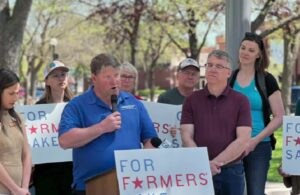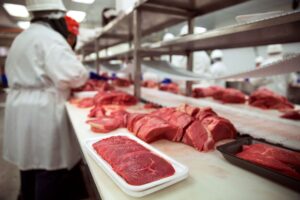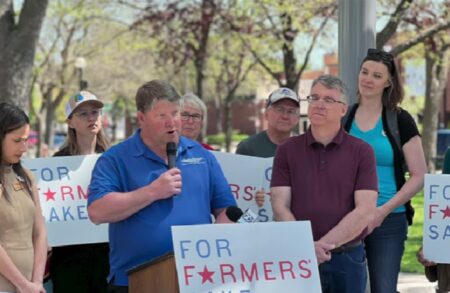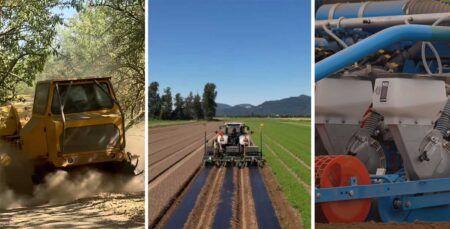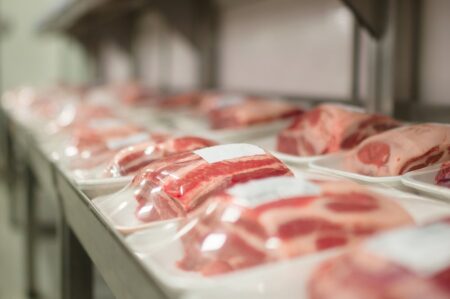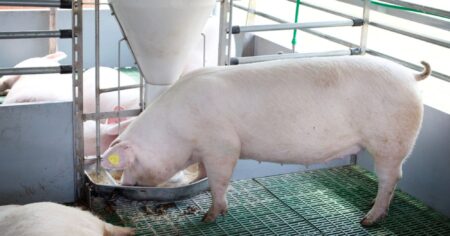By Cami Koons
A study conducted by agronomists at Iowa State University (ISU) found that the slurry left over from turning farm waste into fuel could be a valuable soil amendment.
The study, which analyzed 12 years of data on a commercial-sized farm, found that the byproduct of anaerobic digestion can restore soil organic carbon in active cropland and potentially reduce the need for synthetic nitrogen fertilizers.
Fernando Miguez, an agronomy professor and coauthor of the study, said the anaerobic digestion systems already work to manage manure and contribute to the production of renewable natural gas but the study shows that these systems can also improve soil health on a farm.
“So there’s a lot of pluses, a lot of wins in this kind of system,” Miguez said.
The study was conducted at Sievers Family Farms, a beef cattle, corn, and soybean operation in eastern Iowa. Miguez said the Sieverses had been applying their digestate — the byproduct from their anaerobic digestion system — to their fields for a number of years when he learned of the practice.
“We were interested in what was going on with his soils,” Miguez said about the start of the research. “We know that it can be beneficial, but we wanted to see what was going on.”
Digestate, which is the waste product of the anaerobic digestion of manure and corn stover, can be separated into solid and liquid forms, both of which were applied to Sievers’ fields.
Applying manure to a field is not a new practice for farmers, but Miguez said the digestate, because it has been through anaerobic digestion, has more stable carbon in it compared with the liquid manure typically applied to a field, which means a greater percentage of carbon stays in the soil.
According to the study, fields applied with digestate gained an average 714 pounds of carbon per acre per year. Over the time of the study, the fields had an average 9% increase in soil organic carbon.
But fields with lower starting levels of soil organic carbon benefited more from the addition of digestate. On average, the carbon in these fields increased 47% over the span of the study.
Anaerobic digestion is the process of bacteria breaking down organic material, such as manure, corn stover or even food scraps, without oxygen. This process creates a methane-rich gas that can be used for electricity, heat, vehicle fuel, and more. According to Iowa State University, there are about 20 on-farm anaerobic digestion systems in Iowa.
The process of agriculture typically removes organic carbon from the soil. Practices such as cover crops and reduced tillage try to retain soil organic carbon. Lisa Schulte Moore, the director of ISU’s Bioeconomy Institute and coauthor of the study, said it’s “very difficult” to build soil organic carbon while the land is in row-crop production.
“It’s remarkable to see soil organic carbon increase that much over 12 years in a corn-cropping system,” Schulte Moore said in a news release from ISU.
Bryan Sievers, who owns the farm with his wife, Lisa Sievers, said in the release that the study quantifies the in-the-field observations he has seen on his property.
“It validates what we have long believed — that we’re seeing enhancements in the health of our soil, which has translated into improved yields,” Sievers said. “Now, we can start to assign a monetary value to these best management practices. And that’s what I’ve been seeking all my life in farming.”
Miguez said the measurements of soil carbon show the digestate is improving soil health over time, but the next step in the research is to see how the addition of digestate impacts yields and other soil nutrient metrics.
Miguez said the research team has run nitrogen trials at the farm, but hasn’t yet analyzed the data to know how the digestate is impacting soil nitrogen levels.
This data would be important because it could be a way for farmers to add nitrogen to their soils without the cost of synthetic fertilizers. Farmers such as Sievers, who have anaerobic digestion systems, could also potentially market and sell the digestate to other farmers.
Miguez said the research also indicated the digestate created increased levels of phosphorus in the soil, which Miguez said leads researchers to believe that digestate could be produced with different properties that could then be matched to the nutrient needs of a certain field.
The study did not analyze the impact that digestate application has on water quality, though Miguez said it is something he would like to study.
Anaerobic digestion is still a relatively new practice in Iowa, but many farmers are attracted to the technology’s ability to manage manure, and provide an additional revenue stream if the farmer is able to sell fuel generated by the breakdown of materials.
“I hope people recognize that there’s a potential for: one addressing the management of manure … addressing the production of renewable natural gas … the potential to process food waste, and we can also show that we can improve soil health and reduce the reliance on synthetic nitrogen fertilizer,” Miguez said.
Iowa Capital Dispatch is part of States Newsroom, a network of news bureaus supported by grants and a coalition of donors as a 501c(3) public charity. Iowa Capital Dispatch maintains editorial independence. Contact Editor Kathie Obradovich for questions: [email protected]. Follow Iowa Capital Dispatch on Facebook and Twitter.



